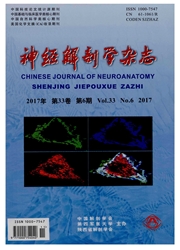

 中文摘要:
中文摘要:
为确定诱导大鼠骨髓基质细胞(BMSCs)向神经元样细胞转分化的适宜培养代数,本研究比较了不同培养代数的BMSCs的转分化潜能。首先体外培养大鼠BMSCs并传代,于不同的培养代数利用碱性成纤维细胞生长因子(bFGF)、神经生长因子(NGF)、全反式维甲酸(RA)、音猬因子(Shh)诱导分化,随后运用免疫荧光法和免疫印迹法检测诱导细胞中的神经元样细胞。结果显示骨髓基质细胞体外培养1至3代时能够被诱导分化为神经元样细胞,培养至第7代时丧失转分化为神经元样细胞的潜能。上述结果提示:传代次数增多将引起BMSCs自发分化,使其向神经元样细胞转分化的能力下降,因而BMSCs培养至第3代时适宜进行诱导分化。
 英文摘要:
英文摘要:
To determine the best time for transdifferentiating rat tbone marrow stromal cells (BMSCs) into neuron-like cells,we compared the transdifferential potential of rat BMSCs at different passages. Rat BMSCs were harvested from normal rat bone marrow, then purified and passaged. The agents including bFGF, NGF, RA and Shh were used to induce the transdifferentiation of BMSCs at 3 different passages. The immunofluorescence and Western blotting were applied to detect the neuron-like cells. The results showed that rat BMSCs at passage 1 and passage 3 appeared neuron-like morphology and structures under the circumstance of induction, while rat BMSCs at passage 7 failed. The results suggest that transdifferential potential of rat BMSCs to neuron-like cells will decrease after several passages. So at the passage 3, rat BMSCs are suitable for transdifferentiation.
 同期刊论文项目
同期刊论文项目
 同项目期刊论文
同项目期刊论文
 期刊信息
期刊信息
